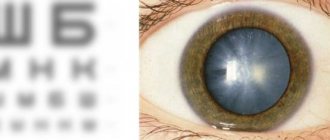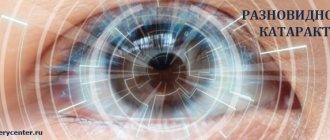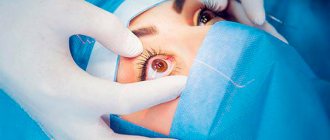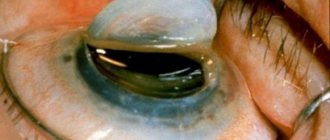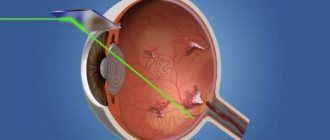Cataract is a dangerous disease that causes clouding of the lens of the eye. Vision begins to rapidly deteriorate. Replacing the clouded lens can help with this pathology. In order to achieve a lasting therapeutic effect, it is important for patients to follow the recommendations of the ophthalmologist in the postoperative period.
In this article
- What sensations does a person experience after lens replacement?
- Limitations after cataract removal and possible complications
- Wearing a special bandage after surgery
- Use of eye drops during the rehabilitation period
- Nutrition rules during the rehabilitation period
What sensations does a person experience after lens replacement?
Surgery is stressful for most people. Replacing the lens for cataracts is a very serious operation. This is a complex technical process. In modern ophthalmology clinics, doctors use special laser devices to remove cataracts. This makes the operation safer. The use of a laser involves less intervention in the body than previous operations. Replacing the lens with an artificial one is usually carried out on an outpatient basis. This means that a few hours after cataract removal the patient can leave the clinic. But this is only possible if the ophthalmologist does not detect any postoperative complications. If the anesthesiologist used anesthesia by intravenous injection to carry out the intervention, then you will still have to stay in the clinic. Health care providers should monitor the patient after lens replacement if the surgery was performed under general anesthesia.
The ophthalmologist will apply a sterile bandage over the eye affected by cataracts, and therefore the quality of vision will be reduced. It is advisable that, after removal of the affected lens, the patient is accompanied home by someone close to him. The bandage can be removed the next day. If the patient is planning a morning walk, then it is better to play it safe and put sunglasses on his eyes. During the postoperative period, patients report such unpleasant sensations as:
- blurred vision;
- itching in the area of the operated eye;
- presence of a foreign body in the eye;
- headache.
These sensations usually last no more than 7 days. During the postoperative period after cataract removal, the ophthalmologist may prescribe medications, for example, Paracetamol or Ibuprofen. During the first 24 hours after replacing the affected lens, you should remain in bed. The body should be in a horizontal position, and the visual organs should not be strained by watching TV or reading books.
Indications for eye lens replacement
Doctors resort to replacing the natural lens with an artificial one in the following cases:
- Cataract. With this pathology, the lens becomes cloudy, the pupil loses its black color, which leads to a sharp deterioration in vision, which is difficult to restore with the help of correction devices (glasses and contact lenses). The lens is also replaced for overripe cataracts and for opacities accompanied by glaucoma.
- Dislocation and subluxation of the transparent body of the eye.
- Presbyopia or “age-related farsightedness” is an eye disease that makes it difficult to distinguish small objects and details at close range. This happens due to the physiological aging of the body. The lens becomes denser, and it is more difficult for it to change its curvature when focusing.
- Astigmatism is a common refractive error that occurs due to irregularities in the shape of the lens, cornea, or eyeball. A person with this diagnosis has to constantly squint to see objects. Everything seems blurry, indistinct. If astigmatism progresses and other treatment methods do not help, then replacing the eye lens becomes the only way to restore good vision to the patient.
- Myopia. Today, the lens replacement procedure is also practiced for myopia. The operation becomes an alternative to standard correction methods. It is often necessary for a high degree of myopia, which is accompanied by anisometropia (a significant difference in the refraction of the right and left eyes).
Limitations after cataract removal and possible complications
Implies a postoperative period of restriction. Following the recommendations of an ophthalmologist will help shorten the rehabilitation process and reduce the risk of complications. One of the postoperative restrictions concerns hygiene procedures. Washing or taking a shower is a natural desire of every person. Doctors do not prohibit doing this. The main thing is that no soap, shampoo or shower gel gets into the operated eye. The rehabilitation period after eye lens replacement is characterized by the following contraindications:
- avoiding head tilt;
- use of decorative cosmetics;
- touching the operated eye;
- prolonged exposure to the sun without special glasses;
- increased physical activity, including heavy lifting;
- lying on the side on the side of the operated eye;
- refusal to visit the pool or open water bodies.
All restrictions during the rehabilitation period after eye lens replacement are temporary. They are aimed at speedy healing of the eyeball. If the patient follows the recommendations of the ophthalmologist, he will be able to achieve faster vision recovery and reduce the risk of postoperative complications. If you do not follow the doctor’s advice regarding treatment, you may encounter such unpleasant phenomena as:
- Infectious inflammation. If cataract surgery was performed in a modern clinic, then the risk is usually unlikely, but its possibility should not be excluded.
- Cloudiness of the lens capsule of the operated eye. This happens when epithelial tissue cells grow, causing the patient to see worse than before surgery.
- Swelling of the cornea of the eye, which occurs due to the introduction of surgical instruments into the eyeball. In most cases, swelling goes away on its own within the first day.
- Increased intraocular pressure. This usually occurs due to the use of solutions during lens replacement surgery.
- Loss of the ability to clearly distinguish objects that are at different distances from the eyes: both far and near.
These are the main types of complications that are likely after a lens replacement for cataracts. The postoperative period may be prolonged if the patient has chronic diseases.
Cataracts - Treatment Overview
Currently, surgery is the only effective treatment for vision loss caused by cataracts.
Cataract surgery is a common procedure that involves removing the cloudy lens of the eye (cataract). The lens allows the eye to focus.
The lens may be replaced with an artificial lens called an artificial lens (IOL), or glasses or contact lenses may be prescribed to compensate for poor vision.
In many cases, surgery is not necessary, or may be delayed for many months or even years. Many patients with cataracts live normally with the help of glasses, contact lenses, and other methods of improving vision.
The choice of treatment for cataracts in children depends on the likely problems they may encounter in the future in developing normal vision.
Whether an adult with cataract disease needs surgery depends on the degree of vision loss and whether it affects the patient's quality of life and ability to function.
Decision: Should I have surgery?
Things to think about
Sometimes cataracts must be removed because of another eye disease, such as diabetic retinopathy or macular degeneration. In some cases, cataracts must be removed so that the eye doctor can view the retina and optic nerve at the back of the eye.
Misconceptions about cataracts have become very common. In recent years, the number of medical services associated with cataract surgery has increased. The strategy of some marketing companies is aimed at encouraging older people who have decided to undergo cataract surgery when, in fact, they really do not need it. Because of fear of blindness or loss of independence, older people may think that they really need surgery, even when their cataracts do not affect their quality of life. In many cases, wearing glasses or contact lenses or using other methods to improve vision can be much more effective without any of the risks associated with cataract surgery.
Only you can decide whether cataracts affect your vision and your life enough to warrant surgery. If surgery fails to improve your vision, you may be able to make the right decision not to have surgery.
Cataracts - treatment at home
If you have cataracts, these tips and tricks will help you manage your vision problems while avoiding surgery:
- Tips for improving vision
include proper placement of light and early prescription of glasses or contact lenses. - Using sufficient and correct lighting in your home and the correct placement of carpets and furniture will help you avoid potential hazards and make your living easier and safer for your eyesight.
- Benefits for improving vision
, as well as video systems and computer system software can help people with low vision to make the most of their remaining vision.
What is clear is that making certain lifestyle changes, such as quitting smoking and protecting your eyes from bright sunlight, can help slow down the development of cataracts.
After cataract surgery
Your doctor will instruct you in detail about how to behave and what to do after cataract surgery. Main eye care after cataract surgery includes using eye drops correctly and protecting your operated eye from possible infection.
Contact your doctor immediately if you notice any signs of complications, such as:
- Decreased vision.
- Increased pain.
- Increased redness.
- Tumor around the eye.
- Any trouble or tension in the eye.
- Any new floating objects, flashes of light, or changes in the field of view.
It is normal to have slightly blurry vision and some swelling after surgery. It will take a short time for the swelling to go away. Your previously prescribed lenses may change after surgery.
Cataract - Medicines
For a short time, a small number of adults and children with cataracts may benefit from eye drops that dilate the pupil. These eye drops increase the amount of light entering the eye. They can also be used for children under 2 years of age who have cataracts, thereby preventing vision loss until surgery can be done.
Eye drops that dilate the pupil and cataracts
Eye drops that enlarge (dilate) the pupils of the eyes can allow a person to see if they have cataracts. Mydriatic eye drops are rarely prescribed for cataracts and are only used for a short period of time. The decision to use eye drops should be made after discussion with an ophthalmologist about the possible benefits of their use.
Eye drops can also be used in infants and children under 3 years of age to enlarge the pupil, allowing light to more easily pass through the cataract, which covers only part of the lens. Because the light reaches the retina more easily, the child's vision can be saved. After 3 years, the growth rate of the eyeball usually slows down significantly. In this case, cataract surgery and replacement of an appropriately sized lens (intraocular lens (IOL)) can be used with great success.
Mydriatic medications are not used for patients who have certain types of glaucoma.
Things to think about
There are currently no medications that can cure cataracts.
Cataract - surgery
Cataract surgery involves removing the cloudy lens of the eye (lens). The lens may be replaced with an artificial lens called an artificial lens (IOL). Or, if the lens cannot be replaced for some reason, contact lenses or glasses may be used. In most cases, an artificial lens is replaced during surgery.
Before surgery, you should discuss the pros and cons of each lens type with your doctor. If your lens cannot be replaced, discuss the pros and cons of wearing contact lenses or glasses.
- Intraocular or intraocular lens (IOL). There are many types of intraocular lenses available. Your doctor will choose the type of lens that is best for you.
- Contact lens. The contact lens is placed on the surface of the eye. A contact lens may not be the best choice for young children and older people who have difficulty fitting the lens into the eye properly.
- Glasses for cataracts. Glasses for cataracts have been used for many decades when there were no other options for lens replacement. Because the glasses are thick and heavy, they are now rarely used.
For most adults, surgery is only necessary when vision loss caused by cataracts affects your quality of life.
The purpose of surgery for patients with cataracts includes:
- Improved vision.
- Help the patient return to a normal lifestyle.
Should I have surgery?
The choice of whether or not to perform cataract surgery in children depends on how likely the cataract is to interfere with the development of normal vision. Surgery is necessary in many cases.
Before you agree to have cataract surgery, tell your doctor about all the medications you are currently taking. Your doctor may tell you to stop taking medications such as alpha blockers (such as terazosin) before surgery to prevent possible complications.
Second operation
In adults who have cataracts in both eyes, surgery is not usually done on both eyes at the same time. The first eye needs to heal and your doctor will determine how much your vision has improved before surgery is performed on the second eye.
If you have both glaucoma and cataracts, you may be offered surgery for both conditions at the same time. Depending on what caused the vision loss, your vision may improve after surgery.
Election Operation
There are two types of cataract surgery. Deciding which one to accept depends on what kind of cataract you have and how experienced the surgeon is in a particular operation.
- Phacoemulsification. This method of surgery makes small incisions and uses sound waves (ultrasound) to break the lens into small, fractional pieces. Currently, this is the most generally accepted method of performing cataract surgery.
- Extracapsular surgery. With this method of surgery, the lens and the anterior part of the capsule wrapped around the lens are opened slightly. The lens is then gently opened on one side. This method uses a small incision and manually breaks the lens into small pieces. Extracapsular surgery is also called extracapsular cataract extraction (ECE).
In the past, cataracts were removed using intracapsular surgery, in which the entire capsule and lens were removed. Intracapsular surgery is rarely used today, if at all, as it is a more difficult surgical method and has a higher complication rate than extracapsular surgery.
Within 5 years after surgery, approximately 1 in 4 patients who have cataract surgery will develop opacification of the second lens, called a secondary cataract.
. But this clouding, if it develops, is usually not a serious problem and can be easily removed with laser surgery (laser capsulotomy). This type of surgery is done on an outpatient basis.
Things to think about
For adults, cataract surgery is almost always elective and can be done at your convenience. A surgeon or nurse will usually provide follow-up care and treatment. Unless you have another eye disease, such as glaucoma or retinal problems, it is best to see a doctor after your cataract surgery has been successfully performed. But you may still need glasses for reading or close viewing.
Just because you have cataracts does not mean you need to have them removed. Only you can decide whether cataracts affect your vision and your life enough to warrant surgery. Research everything related to the surgery and consult with your doctor before agreeing to have the surgery.
Cataracts - Other Treatments
Using modern methods and treatments, it is possible to significantly improve vision in older people in order to avoid or delay cataract surgery for a longer period.
Choosing an Alternative Treatment
Recommendations for improving vision include:
- Proper lighting of the room and timely replacement of glasses prescribed by the doctor.
- In apartments with poor lighting, add additional lighting and adjust existing carpeting and furniture to avoid potential hazards.
- For poor vision, special benefits and adaptation systems
which include video enhancement systems and speech software for computer systems.
Things to think about
Vision aids can be used on a short-term basis until you decide to have surgery, or on a long-term basis to avoid surgery.
Surgery may be advisable if you want to continue driving. If you live at home, are retired, or are a caregiver, you can use vision benefits to avoid surgery.
Tips for improving vision with cataracts.
Some of these tips might help you adjust to minor vision problems caused by cataracts.
- The lighting of the room should be sufficient, and window blinds are used to avoid glare from television or computer screens.
- Use table lamps or floor lamps for reading and other manual work, moving the light sources closer to the work area.
- Use more lighting or higher wattage lamps on stairs or in hallways.
- Use glasses or contacts recently prescribed by your doctor. Avoid your prescription glasses if you decide to have cataract surgery.
Cataracts - prevention
There is no proven way to prevent cataracts. However, following certain habits and a healthy lifestyle can help slow the progression of cataracts. These include the following:
- No smoking.
- Wear hats or sunglasses when in the sun and avoid exposure to ultraviolet lamps and tanning booths.
- Eat a diet rich in vitamins C and E. Eat at least 3 servings of fresh fruits and green vegetables every day and take a multivitamin every day. There is no definitive proof that these products prevent cataract formation, but researchers are studying their effects.
- Limit the amount of alcohol consumed.
- If possible, avoid using steroid medications (some people need them).
- Keep diabetes under control.
Wearing a special bandage after surgery
Replacing the lens for cataracts, the postoperative period after it, to be more precise, must be accompanied by wearing a special bandage. It acts as a protective “scene” of the operated eye from all kinds of contamination. The bandage protects the visual organs from exposure to bright light, ultraviolet rays, dust particles, dirt, etc. It is not necessary to buy it at the pharmacy. You can easily make the bandage yourself. There are many instructional videos available on the Internet that demonstrate in detail how to make a drawstring headband. To do this, you will need an adhesive plaster and sterile gauze.
The bandage is attached to the forehead using adhesive medical tape. Wearing such a “curtain” during the postoperative period is very important. It does not interfere with the eyes and allows the patient to perform most of the usual activities. The bandage needs to be changed daily. It cannot be reused. This is dangerous for the condition of the visual organs. During rehabilitation, it is important to follow the following rule: when replacing the bandage with a new one, the eyelids should be wiped with a special solution.
For this purpose, 0.02% furatsilin, a broad-spectrum antimicrobial drug, or 0.25% chloramphenicol, a bacteriostatic antibiotic, is suitable. The most convenient way to apply one of these solutions is with a cotton pad.
When should lens replacement surgery not be performed?
Before the operation, the patient undergoes an examination, during which the doctor determines whether or not there are contraindications to the procedure. There are a number of factors that prevent the appointment of surgery:
- inflammatory and infectious diseases of the visual organs: keratitis, conjunctivitis, blepharitis;
- small size of the anterior chamber of the eye;
- detachment, rupture of the retina;
- a small eyeball, which leads to progressive farsightedness;
- swelling, clouding or scarring of the cornea;
- decompensated glaucoma - an acute attack of glaucoma, accompanied by a sharp increase in intraocular pressure;
- diabetes mellitus and serious diseases of internal organs;
- stroke or heart attack suffered in the last six months;
- pregnancy and lactation (an anesthetic solution will be injected, which may enter the fetus).
Some of these contraindications are absolute, for example, diabetes, they completely exclude the possibility of lens replacement. Some restrictions are relative in nature, that is, surgery is possible, but only after all conditions have been created (for example, after an infectious disease has been cured).
Use of eye drops during the rehabilitation period
Eye drops in the postoperative (rehabilitation) period are a mandatory medicine. When used correctly and following the recommendations of an ophthalmologist, they help to reduce recovery after removal of cataracts that have affected the lens. Regular instillation of them into the eyes according to the doctor’s recommendations will protect the visual organs from various infections. The purpose and order of dosing drops for patients who were recently diagnosed with cataracts by ophthalmologists are individual. The instillation schedule during rehabilitation should be determined by the doctor who performed the operation and, if necessary, adjusted at each examination of the patient.
The following groups of drops are usually used:
- antibacterial (“Tobrex”, “Floxal”, “Flucitalmic”);
- anti-inflammatory (“Albucid”, “Vitabakt”, “Uniflox”);
- combined (“Dexona”, “Garazon”, “Tiotriazolin”).
In order not to injure the eye during treatment, you should follow simple rules. Before use, wash your hands thoroughly with soap. It is most convenient to put drops into your eyes with your head tilted back. You need to carefully pull the lower eyelid down with your finger, then turn the bottle over and press on it. After performing this procedure, you should close your eyes and blink. Next, you should apply an integral attribute of rehabilitation - a sterile bandage. One of the postoperative restrictions is strict adherence to the “break” if the ophthalmologist prescribed several drops at the same time. It should be at least 5 minutes.
Is it possible to drive a car after laser dissection of the posterior capsule?
As mentioned above, the rehabilitation period after laser removal of secondary cataracts is quite easy and painless. However, there are a number of restrictions that you should not forget about during one month. Prohibitions include:
- any physical activity and sudden movements (even bending forward and backward);
- drinking alcohol as it interferes with the healing of the visual system;
- visiting saunas, baths and swimming pools;
- long walks without sunglasses;
- eye strain.
Patients should pay special attention to the last point. It is not recommended to use gadgets for a long time, work at a computer, watch TV and read, or drive a car.
This is due to the fact that laser dissection of the posterior capsule requires some time to fully restore vision. Since the driver is not physically accustomed to high visual acuity and a clear picture in the first 30 days, he does not yet assess the real distances between objects. The process of driving a vehicle requires increased concentration of the visual organs, and this leads to their overwork.
Doctors also recommend protecting your eyes from exposure to ultraviolet radiation even after the end of the rehabilitation period. Therefore, you should give preference to high-quality sunglasses with a reliable UV filter.
Nutrition rules during the rehabilitation period
The postoperative period does not imply any special restrictions in terms of nutrition after lens replacement. This means you don’t need to follow any diets. It is recommended to maintain a proper diet and drink enough fluids daily. During rehabilitation, you should avoid fatty meats, lard and any fried foods. After cataract removal, preference should be given to products that contain vitamin A, a fat-soluble element belonging to a group of substances called “retinoids.”
On average, a healthy person is recommended to consume at least 900 mcg per day for men and 700 mcg for women. Rehabilitation after lens replacement somewhat “corrects” these values, doubling them. Vitamin A is present in foods of animal and plant origin. Animal sources are called retinoids. There are especially many of them in the liver of marine fish and mammals. Rich in this substance, useful during the postoperative period of lens replacement: fish oil, caviar, egg yolk, milk, sour cream, cottage cheese, butter, margarine.
Plant sources - carotenoids. By the way, the name of this group of substances comes from two words: the Latin carota, which means carrot, and the Greek eidos, which means species. They are found in plant sources and one of the main ones is carrots. There are a lot of carotenoids in broccoli, spinach, parsley and other green vegetables. Legumes will help speed up the rehabilitation period, for example: peas, beans, soybeans, chickpeas (“chickpeas”). After the cataract has been removed, you should increase your consumption of yellow-orange fruits and berries. Quite a lot of vitamin A is found in apricots, peaches, melon, sea buckthorn and light varieties of cherries.
VISUAL ACUITY AND SELECTION OF GLASSES
Your vision will improve significantly in the first days after surgery, but the final result after cataract removal with implantation of an artificial lens will be achieved after 1 month. During the healing and rehabilitation period, your eyes may look different. You may need temporary glasses or contact lenses to correct this situation. Once your eye is completely healed (1 month after surgery), you will be prescribed new glasses, either for reading or distance.





